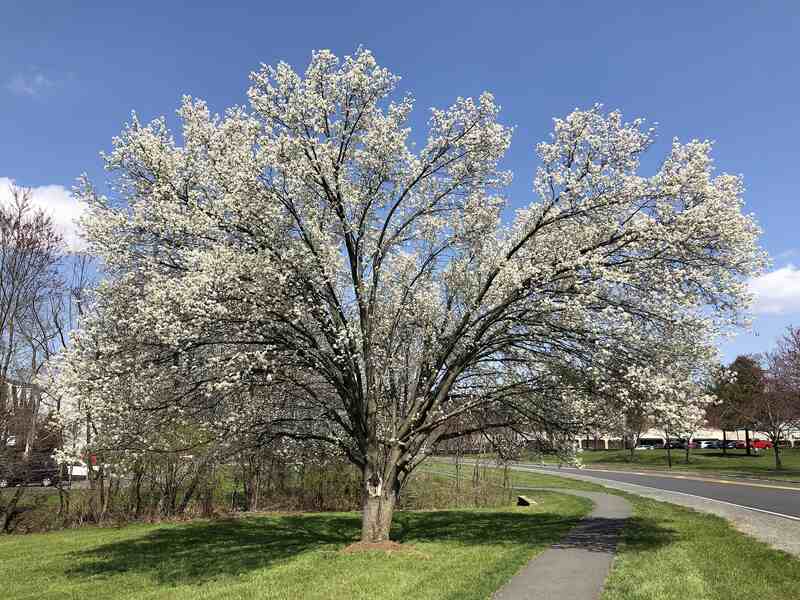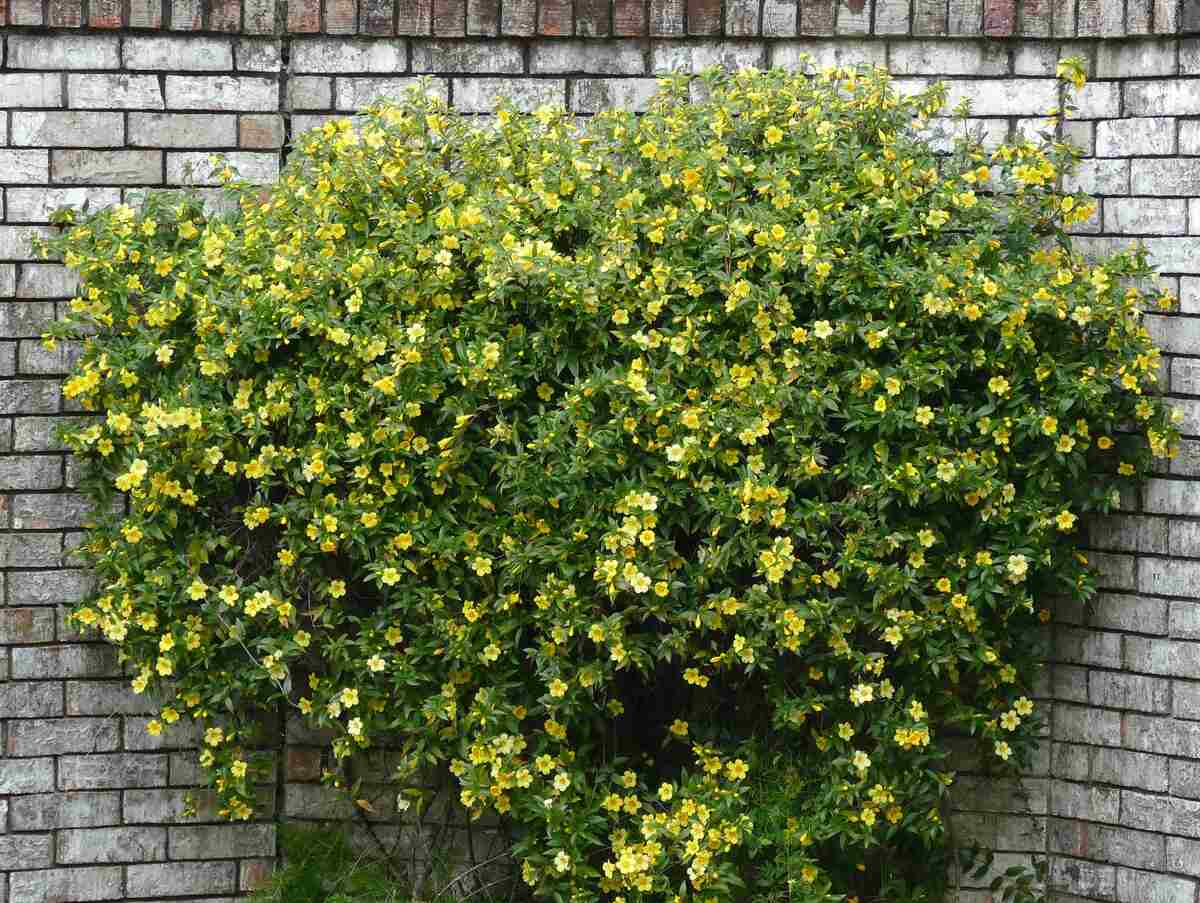
Although adding trees to your yard is a great way to spruce it up, some trees are better off not planting in Jacksonville, Florida. Jax has dozens of native and non-invasive tree species that grow well and raise your curb appeal – including some wonderful shade trees. It’s easier to list the species that should never be considered for your yard. Here are our en-trees for the worst trees to plant in Jacksonville and most of Northeast Florida:
1. Bradford Pear

Photo Credit: Famartin / Wikimedia Commons / CC BY-SA 4.0
Species name: Pyrus calleryana
The Bradford pear tree is the most popular cultivar of the Callery pear, beloved by Floridians for its fast growth, ample shade, and beautiful white flowers. However, this lovely sight is accompanied by an absolutely awful stench; some people compare its scent to mold or even rotting fish.
Its fast growth is also a strike against it. Because it grows so quickly, its wood is quite weak. It grows multiple trunks that often split and topple during strong winds like in hurricanes or hurricane-like conditions.
As a fast-growing non-native tree, it’s also become a pest and is considered to be an invasive weed. It grows quickly almost anywhere, and it produces seeds at a pace that’s difficult to manage. It doesn’t help that birds like to eat the seeds, which spread far and wide in their droppings.
Alternative options: Southern magnolia and flowering dogwood trees have similar whitish flowers. While they have their own issues, they’re not invasive or stinky.
2. Laurel Oak

Photo Credit: Bruce Kirchoff / Wikimedia Commons / CC BY 2.0
Species name: Quercus hemisphaerica
Laurel oak trees and their close cousin, the swamp laurel oak (Quercus laurifolia), are often grown as shade trees, but they’re not the most ideal choice for Jacksonville. Aside from their wood’s tendency to break, their lifespan is considerably shorter than live oaks. These trees grow quickly, maturing early at around 25-50 years and lasting for about 80 years compared to the potentially hundreds of years a live oak can thrive.
The laurel oak’s weak wood often becomes an issue once they reach about 40 to 50 years of age, as their trunks start to decay and hollow out at that age. This can cause the tree to collapse, which is disastrous if it happens to be planted near your house or car. Old trees are even more likely to topple during a hurricane.
North Florida homeowners that really want one of these trees should plant it far away from their houses.
Alternative option: Live oaks also provide lots of shade. Make sure you have enough space for these trees to grow large and strong.
3. Camphor Tree

Photo Credit: haram.koh / Flickr / CC BY-SA 2.0
Species name: Cinnamomum camphora
Imported into Florida in 1895, the camphor tree is an invasive species. While growing it isn’t prohibited like other invasive trees, the University of Florida Institute of Food and Agricultural Sciences (UF/IFAS) doesn’t recommend planting this species at all. Camphor trees produce up to 100,000 seeds in their poisonous berries, which are one of many of the tree’s parts that are toxic to humans and pets.
This prolific reproduction, coupled with the ability to grow in salty marshes and sandy soil, lets them outcompete native tree species, some of which are endangered.
Alternative options: UF/IFAS suggests the following local trees as alternatives to the camphor tree:
- Dahoon holly
- Southern magnolia
- Sweet bay
- Red bay
- Sand live oak
- Live oak
- Winged elm
4. Paper Mulberry

Photo Credit: Kware Ji / Flickr / CC BY 2.0.
Species name: Broussonetia papyrifera
Named for its historical use as material for paper, the paper mulberry is our next en-tree. It is invasive in the city of Jacksonville and the rest of Florida. The Florida Exotic Pest Plant Council classifies it as a Category II invasive species because of how well it can outcompete native species.
You may want to plant paper mulberry because it’s an excellent shade tree, but it’s actually a little bit too good at this job; grass and other plants have trouble growing beneath its canopy. It’s also rather difficult to remove because it sprouts from its roots.
Lastly, paper mulberry and many of its relatives are bad options if you don’t like your home, car, or driveway splattered with purple. Their fruits stain everything they touch, including bird droppings that will also stain their landing zones.
Alternative options: UF/IFAS recommends these paper mulberry alternatives:
- Red maple
- Hackberry
- Black gum
- Sassafras
5. Mimosa

Photo Credit: Rusty Clark, CC 2.0.
Species name: Albizia julibrissin
Imported by arborists around the 1740s, the mimosa tree is yet another invasive species to Florida. They are popular ornamental trees because of their fuzzy and fragrant pink flowers, which bloom from May through July. They’re quite beautiful during that time of year!
However, they’re a problem outside of that time period, especially when they start producing their poisonous seeds. Mimosa seeds are viable for up to five years, can spread through water and wind, and can thrive in nearly all types of soil, so they can easily find another place to wreak havoc.
That’s not the end of the headache a mimosa can bring. These trees are fragile, prone to insect damage, and easily afflicted with diseases. Mimosa wilt is one of the most common diseases, causing leaves and branches to yellow and wilt and eventually killing the tree. It spreads quickly, especially because diseased trees can produce seeds that sprout diseased plants. You’ll end up with many dead trees that will need to be removed.
To top it all off, they’re quite difficult to get rid of. Their strong roots – which can lift and crack concrete – make pulling young sprouts hard, and mature trees can regrow even after being cut down.
Alternative options: If you like the aesthetic of mimosa trees, UF/IFAS recommends these plants:
- Sweet acacia
- Red bottlebrush
- Dward powderpuff
6. Weeping Willow

Photo Credit: Antilived / Wikimedia Commons / CC BY-SA 3.0
Species name: Salix babylonica
While pretty, weeping willows shouldn’t be planted unless you have lots of water and land on your property. These trees grow very large and are very thirsty. Weeping willows planted near underground water, sewer lines, and septic tank drain fields can wreak havoc as their roots grow far and wide, and rather aggressively so. Their roots can crack sidewalks and foundations, too.
Weeping willows grow very quickly, and much like other quick-growing trees on our list, they have weak wood. Their large size – up to 50 feet tall and 50 feet wide – plus their frailty is a recipe for disaster in a Jax neighborhood during hurricane season. They also have short lifespans, lasting only about 20-30 years – at least they won’t be around to cause problems for too long.
Alternative option: The Jacksonville Zoo and Gardens recommends the following weeping willow alternatives that can handle wetness:
- River birch
- Dahoon holly
- Coastal plains willow
- Southern magnolia
- Bald cypress
- Maples
FAQ
Any type of tree that isn’t too big, doesn’t have shallow roots, and is strong enough to withstand strong winds is a pretty good candidate for planting near the house. You can check our article on the best shade trees to plant in Jacksonville or check this list from UF/IFAS.
There are a few tree species that Floridians are legally prohibited from planting on their properties. Some of these species are:
● Australian pine
● Brazilian peppertree
● Chinese tallow
● Carrotwood
There are more species, but some of them are shrubs, ferns, vines, and other types of plants.
It’s best to get rid of them. If you can’t, at least try to prevent them from propagating to prevent them from spreading further. Then, if you choose to replace it, consider going with a native tree.
Get Some In-Tree-Guing Additions to Your Jacksonville Property
Trees can beautify your home and yard, provide shade, and host native wildlife when cared for properly. Just make sure to do your research before planting one of these towering beauties on your property; you’ll need to steer clear of any of the worst trees to plant in Jacksonville.
If you have any trees that need to be taken care of or removed, it’s best to leave them in the hands of a professional tree care company. Find a Jacksonville tree care specialist near you today.
Main Image Credit: Michelle DeRepentingy / Flickr / CC BY 2.0




